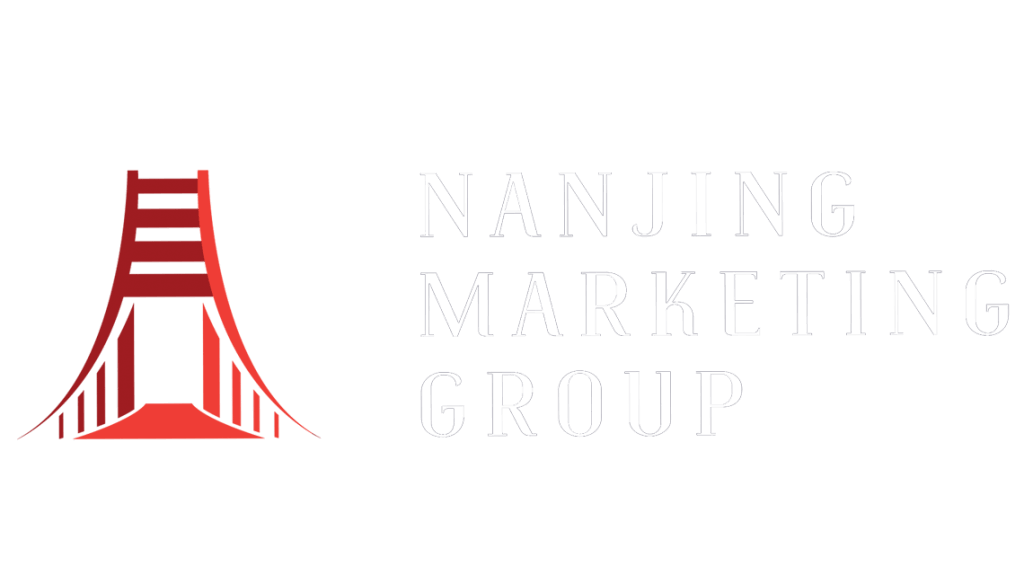In my job, I talk to marketers, executives, and business owners every week.
A lot of them seem surprised by our approach to content marketing, and I can understand that. Our strategy might be somewhat similar, but we don’t compartmentalize our marketing in the same way.
At NMG, we adopt a more holistic approach to our marketing efforts: We don’t have a separate B2B social marketing, SEO, or PR service to sell to our clients.
In fact, we merge all of these into just one thing we call content marketing.
Content marketing has the potential to educate your future clients. This generates leads, “warms up” otherwise cold leads, and supports the sales team too.
In this post, I’ll lay out the building blocks of this approach and stack them on top of each other one by one.
English SEO for Google
First, let’s start with the kind of SEO you might be more familiar with.
SEO was my first major marketing strength. Since 2001, I’ve viewed SEO as the backbone of the marketing efforts for my own business initiatives…at least when targeting an English-reading audience.
During university, my part-time business imported electronics from China and sold them online and offline, and we earned traffic through organic search. After graduating, I ran a travel portal, this site you’re currently reading, and about fifteen other niche topical sites.
Using a Google-centric SEO strategy, I could realistically plan and launch a website on a niche topic over just one weekend and start gaining a thousand visitors a month for free from Google. This strategy works, and I’ve done this a handful of times for new site launches.
Google will index and rank even small sites quite quickly so long as it thinks these sites contain valuable content. So high-quality, unique content is a great way to gain traction with Google.
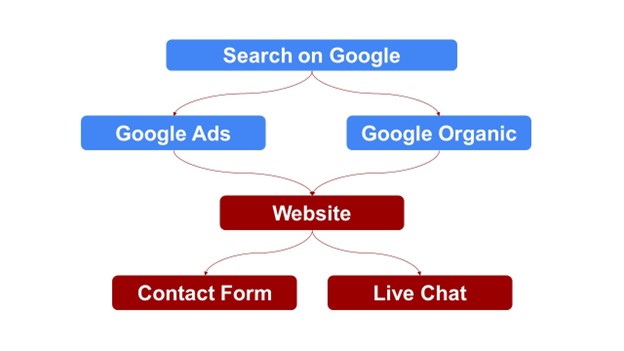
Chinese SEO for Baidu
In China, it’s tougher to use a strategy like this, so I’ve had to revise my approach. For example, when I aimed to make a new Chinese website reach #1 on Baidu for “Los Angeles real estate,” I had a long-term outlook.
I knew we wouldn’t be able to rank that well with just static content. Instead, I created a website with fresh real-estate postings at least every two days.
Baidu loves fresh content and websites that have lots of it. The content I posted for this site was quite simple—It didn’t involve much thought or preparation. However, it was useful to Chinese nationals who wanted to get the basic details about Los Angeles real estate (in Chinese).
It’s not just me who posts frequent, fresh content on a website to rank better on Baidu organic search. Many, many people into Baidu SEO have used the same approach.

Let me share some practical tips about Chinese SEO for your website.
Keep these in mind as you’re planning your China B2B marketing strategy. These tips aren’t set in stone, but they suit at least 80% of the clients we work with:
- Baidu is very important for B2B marketing.
- Baidu gives priority to its own listings as well as those from paying companies. (It takes longer to get a website ranking well on Baidu.)
- It’s great if you have fresh content, such as a homepage containing new articles, listings, or blog posts.
- Your website must be in Chinese.
- Your website needs to load quickly within China.
- Optimize your title tags and meta descriptions (like you would for Google).
- Write your URLs in Pinyin (English letters to spell Chinese words).
- There are technical requirements for Baidu SEO. Some are the same as Google, and some aren’t. See the full post here.
- Learn more about Chinese SEO in our guides.
If you’d like an overview of what Baidu’s search results pages are like, check this video:
Baidu SEO Challenges
Now you understand the basics of Baidu SEO, right?
I recommend you do SEO for your website, but don’t focus too much of your budget on it.
Now, in my experience, our B2B clients normally encounter two obstacles when trying to incorporate Baidu SEO into their marketing strategy. First, they often have new, small websites that are harder to rank because Baidu doesn’t treat these websites as nicely as Google does.
This doesn’t mean we can’t get them ranked (more about this method later in this post).
Second, our clients are often very particular about how their business is portrayed. This makes sense because they sell high-ticket B2B services and hardware. Of course, you can bring in traffic to your website with frequently updated content that doesn’t require much thought or effort on your behalf.
But to convince users to buy, you’ll need something more compelling.
Sound familiar? If any of this relates to you or your business, keep reading.
I generally recommend giving up on trying to get your website to rank very highly within the first year. Instead, there’s a more ambitious but (somehow) easier way to go about this. You should focus on influencing the top few pages of Baidu search results.
In other words, spread content to multiple places besides just your website.
There is one caveat though: You’ll need to be good at creating content. This approach works for us because our clients are very knowledgeable in their niche, and we’re able to craft readable and useful content.
Zhihu
In the early stages, one of the easiest ways to do that will be with Zhihu.
Zhihu is the Q&A platform in China.
It has at least 220 million active users, including white-collar professionals and other curious people. In terms of demographics, according to Zhihu, half of its users are from first-tier cities, and 75% make more than 10,000 Chinese yuan per month.
You can get a feel for Zhihu by checking out my video tour of the platform here.
Zhihu isn’t only a force on its own. It also shows up high in Baidu’s search results. By adding high-quality answers and articles to Zhihu, you start to earn organic search traffic a lot quicker than you could with your own website.
Zhihu is a cheat code for Baidu organic ranking.
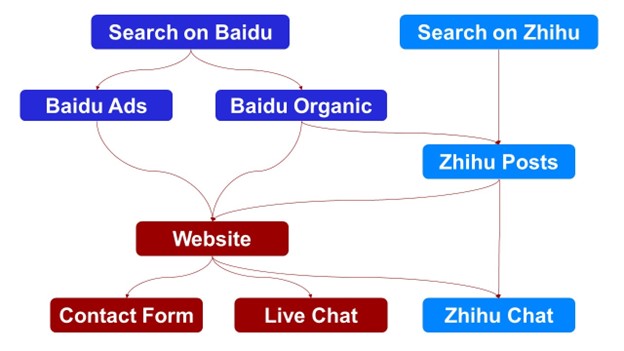
However, Zhihu is a competitive arena, and anybody can add an answer. These answers are voted up/down by users depending on the quality and how well it responds to the initial question.
So, how do you write a great answer? They should be accurate, thorough, easy to read, and authoritative.
Answers should be “ATEA” (like a cup of tea).
- Accurate
- Thorough
- Easy-to-read
- Authoritative
There’s no ideal length. Answers should be as long as necessary to provide the most comprehensive response.
Before submitting, it’s best to check what other users have posted. Naturally, your answer needs to be better than all the others, so you should integrate what’s already on Zhihu with your own insights to create the best possible response.
Easier said than done, right?
On Zhihu, it’s important to write with the specific asker in mind. Remember: You aim to help them resolve their question, so present your advice in a clear and logical format that is easy to absorb.
I suggest using some or all of these elements for B2B answers:
- Restate the original question word-for-word, then clarify any assumptions you make. This shows you understand the question.
- State your credentials, relevant education, and experience. If you’re representing a famous company in your home country or the rest of the world (RoW) market, let them know.
- Use sections and bullet points where applicable. It makes the text easier to parse.
- Cite your sources.
- Add images when they help the reader understand the question. For example, a graph can usually show trends better than numbers.
- Sum it all up at the end.
- Add helpful links to only some answers.
You can link to a page on your website, WeChat, or another post you made on Zhihu. Just don’t add links to all your answers because they could be removed. Your links are a lot less likely to be removed if the connecting page helps the reader understand the topic.
Nurturing the Funnel With WeChat
Now’s a good time to introduce WeChat.
From a user’s perspective, with WeChat, you can
- chat,
- follow brands and friends, and
- discover funny videos.
On top of all this, WeChat is also a
- payment app,
- Slack-like work communication tool, and
- many other things at the same time.
Overall, it’s the EVERYTHING app!
So, you really should be on WeChat. But how? The way a company should use WeChat varies quite a bit depending on the type of company.
Also, please note that nothing recommended above has any impact on WeChat yet. WeChat is a walled garden, separate from Baidu’s ecosystem.
From a B2B marketer’s perspective, WeChat’s main strength is how it allows companies to nurture relationships with fans.
As soon as one of your future clients decides to follow your B2B brand on a WeChat Official Service Account, you can send them new posts each week.
These posts show up right in your followers’ message area, and they’re notified with a push message, so there’s a high chance of your followers opening your posts. Let me break down some terminology for you:
- An Official Account (OA) is a branded account.
- WeChat has two types of OAs (Service and Subscription):
- If you’re a news account publishing daily, you’ll want a Subscription Account.
- If you’re publishing once a week, the Service Account is best. There’s more on this in our WeChat account setup guide.
- Your Service Account posts will show up in your followers’ message areas. They are not hidden by an algorithm and you don’t need to pay to get people to see them.
For B2B brands, we expect the WeChat followers to increase as more people find the account.
We rarely expect B2B content to go viral. If it occasionally does, that’s great, but that’s not the point. The point of WeChat for B2B is to get your fans to follow you. You know, the kind of people who like to nerd out chatting about your offerings, their business, and how these things work together.
What should you post on WeChat?
First, repost the content you prepared for Zhihu and your website. When we do this, we do make some changes:
- Optimize the header for browsers rather than searchers.
- Adjust the layout to make it very easy to read. We use short blocks of text and enough design elements to make it visually attractive.
Next, post content relevant to your clients or people who are lower down in your sales funnel. Some ideas:
- Upcoming events.
- Case studies.
- Special promotions.
When posting on WeChat, remember again that followers receive notifications in their message area.
That goes both ways.
If they see something interesting, they’re very likely to open it; however, if you keep posting redundant, boring, or useless content, they will probably unfollow you.
If you want to know more about harnessing the power of WeChat for B2B marketing, check out this post.
The Big Picture
Let’s take a look at how your future clients might interact with your company on the four most important places for B2B brands: Baidu, WeChat, Zhihu, and your website.
Now, there’s a simple solution to increasing the ROI of your B2B content marketing in China.
When you create long-form content, make sure to share it in at least three places:
- Your WeChat account – Think of this as being like your email newsletter but with built-in social sharing.
- Zhihu (as an article) – Think of it as similar to your blog.
- Your website.
This is a simplified flow chart. For example, people use WeChat for search as well, although that is not something we focus on.
Also, we spread content out to more places than is listed above. We spread it to niche websites, influencers, forums, Baidu’s question platform, Baidu’s wiki, Bilibili (like YouTube), etc.
The overall impact is simple: Wherever potential clients look, they will see your brand.
Repetition is important. So imagine a user flow like this:
- They search for their first problem. There’s you.
- They search for related problems. There’s you.
- They do more research. There’s you.
- They compare companies to buy from. There’s you.
- They decide who to contact first. _________.
If you saw the blank and thought, “there’s you,” well, that’s how the human mind works. You can train people to think about you whenever they think about that niche you specialize in.
Creating an Efficient Workflow
The most common objection I get to this strategy is (something like this): “This sounds very good, but isn’t it better to start with one channel and then expand.”
Yes, that is absolutely correct.
In 2008, I started with one thing (translation); after that, I added Baidu, then I…etc, etc. Now our processes are more mature, which makes it easy for us to get all of this work done efficiently.
The thing to keep in mind: Content creation and publishing it to multiple platforms won’t be your biggest expense.
The number one spot is research. It might have taken you years or decades to get really good at whatever B2B offering you provide.
The second biggest expense for content marketing is creating the core content. By core content, I mean the long-form piece with all meat to it.
After you have that core content, it’s relatively inexpensive to adapt it for use in multiple places. It’s also easy to “transcreate” it into another language and publish it on even more platforms, which is what we do for our clients.
For more on transcreation, please see our how to create multilingual content efficiently blog post.
The image below sums up where our own content is (usually) published and in what order.
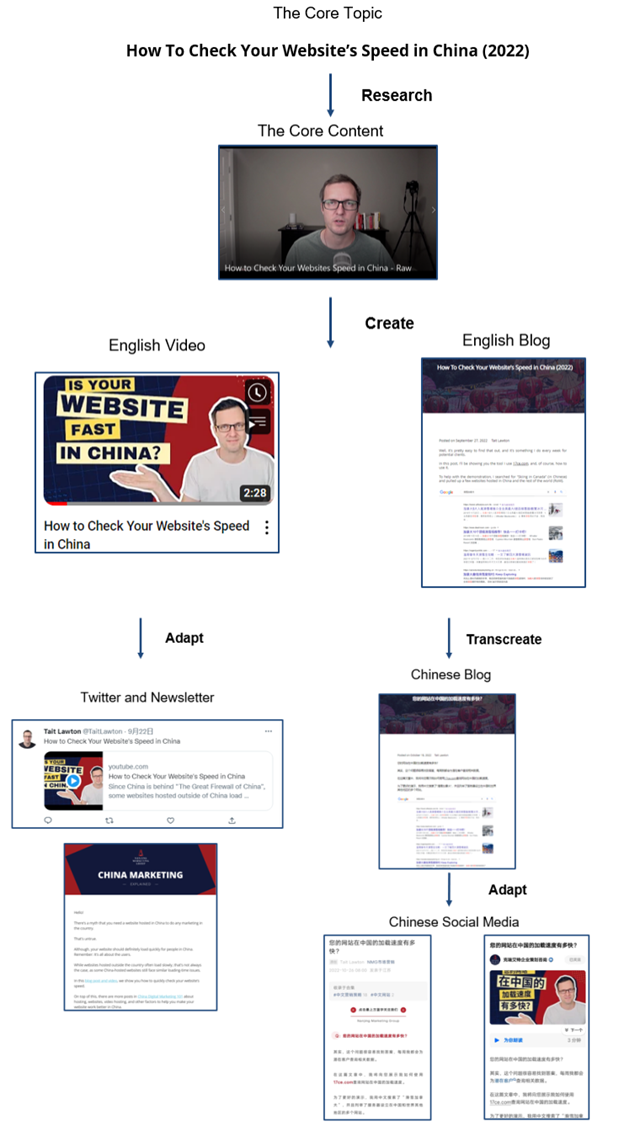
Analyzing Results of Chinese Content Marketing
If you’re posting content in three different places, it might become a bit tougher to analyze results.
Again, I’ll remind you I’m using this three-channel (Baidu, WeChat, Zhihu) method to keep things simple. In other cases, we might have up to twenty different platforms where we publish.
So, how does somebody keep track of that?
It’s not only one person that needs to keep track either. For our work, there’s usually a global team (our clients), a creative team, and managers too. They all want to know what’s going on with the content marketing but tend to look at the data at different levels.
Of course, our team members will dig into the various platforms to collect more detailed information. To get WeChat data only, the WeChat back-end is just fine, but I found that different team members were only looking at data in multiple places.
To fix the problem of the data not being in one place, we use a suite of tools to create interactive visual reports in Google Looker.
After we started using Google Looker reports, it gave the teams a central place to understand the overall situation. They started to bring up these reports in meetings, and it helped them come up with ideas that improve overall results.
Here are a few of the pages we find helpful.
First, we like to have a simple list of the content we published, and how many views it received on each platform.
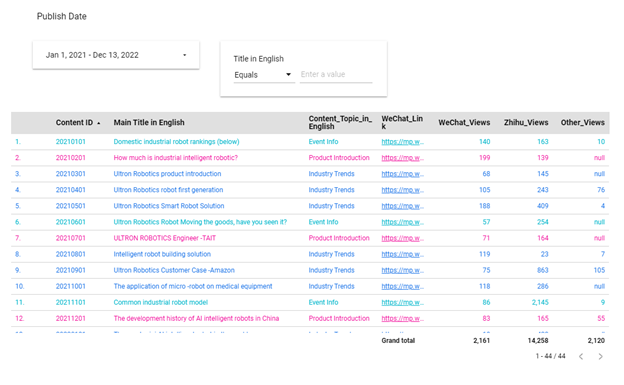
It’s also nice to monitor the number of inquiries across various platforms over time.
Note: To show you what a Google Looker report looks like, we’re using fake data (no “real” data from a case study or campaign).
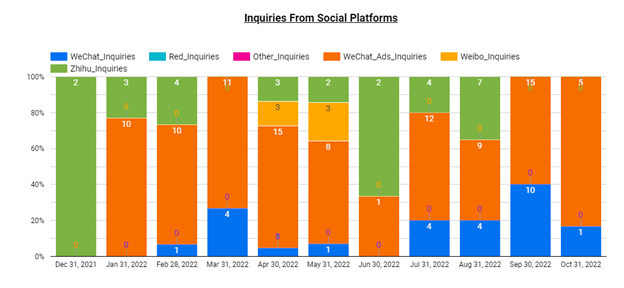
Let’s not forget about SEO results.
Remember: We want to dominate the search results pages but not focus only on the website. So we use SEO tool Dragon Metrics to track the search results for the content we post on Zhihu and other places. You can learn more about Dragon Metrics in my video here.

We gather this data from all available sources: WeChat, Zhihu, Baidu, Google Analytics, etc., and we put it together in one place where everyone can review it.
Having the data organized in this way means it’s easy to see what type of content and platforms are doing best. From there, we can come up with new ideas or otherwise plan how to improve the content marketing results further.
You can see a full dummy report here. For clients, we start with this template and then adjust it for their situation. Feel free to copy it too.
Contact Us
And that’s it for now.
I hope I have demonstrated how these seemingly separate elements can be brought together under one approach—one we just call content marketing.
I’ve covered quite a few different topics in this post, and each one is a big subject area in its own right. If you would like to know about anything in more detail, please check out our China Digital Marketing 101 page.
